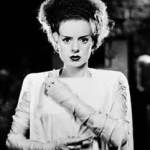 The Bride of Frankenstein is a fascinating entry in the Universal Horror universe. Released in 1935, it stands as one of the most iconic films in the Universal Horror library and is one of the rare cases where the sequel is considered a superior film to the original (Frankenstein); each of these films is so ingrained into our pop culture that it is difficult to critique them.
The Bride of Frankenstein is a fascinating entry in the Universal Horror universe. Released in 1935, it stands as one of the most iconic films in the Universal Horror library and is one of the rare cases where the sequel is considered a superior film to the original (Frankenstein); each of these films is so ingrained into our pop culture that it is difficult to critique them.
The Bride of Frankenstein starts with a prologue featuring Mary Shelly (Elsa Lancaster) being praised for writing Frankenstein. The story proper begins just moments after the supposed death of the creature (Boris Karloff) in the first film. Its creator, Henry Frankenstein (Colin Clive), has barely survived the encounter. After being nursed back to health by his fiancé, Elizabeth (Valerie Hobson), he is visited by his former mentor Septimus Pretorius (Ernest Thesiger); Pretorius has been experimenting with creating life himself, but feels Henry’s work shows more promise. He strong-arms Henry into creating a female body to house an artificial brain of his creation.
While this is going on, the creature is trying to find its way in the world, each encounter with humanity ending in disaster. His only respite comes when he is befriended by a blind hermit (O.P. Heggie) who teaches him to speak. Even that ends badly when some hunters come to the hermit’s hut and see the creature. Eventually, the creature is found by Pretorius and convinced to help him force Henry to complete the experiment, with the promise of making him a mate.
The climax of the movie is the creation of the Bride (also played by Elsa Lancaster). The creature tries to woo her, but she is repulsed and rejects him. The creature makes Henry and Elizabeth flee the laboratory, but forces Pretorius and the Bride to stay, saying of the three of them “we belong dead”, after which he destroys the lab.
The Bride of Frankenstein works on many levels. While the movie may not seem as scary to modern audiences, it still retains a great deal of the dramatic tension that is the hallmark of Director James Whale. Unlike the first film, much more of the story is spent following the creature; this time around he is very much the main character and we see him trying to find his place in a world that will never accept him. Karloff brings the pain and longing of the creature to life brilliantly. Colin Clive has much less to do this time as Henry Frankenstein, but still exhibits the mood swings that led me to believe he is bi-polar from the first film. Ernest Thesiger chews the scenery as Pretorius and, unlike the creature, he is very much a pure villain.
Elsa Lancaster’s performance as The Bride is what makes this film truly remarkable. This characters unforgettable image is completely ingrained in our pop culture, yet the character is on screen for less than five minutes. In that short span of time, Lancaster creates a vivid and memorable performance, making The Bride come off as cruel and vicious, while never really doing much more than reacting to what happens around her.
For trivia buffs, it should be noted that The Bride is the only Universal Monster not directly responsible for a death. It should also be noted that during a showing I attended in the last year, when Henry says “She’s alive, Alive!”, three of us sung “Weird Science” under our breath.
I give The Bride of Frankenstein a grade of A+. It is a true classic horror film, and fans of classic horror will love it, and non-fans will still be entertained by it.
